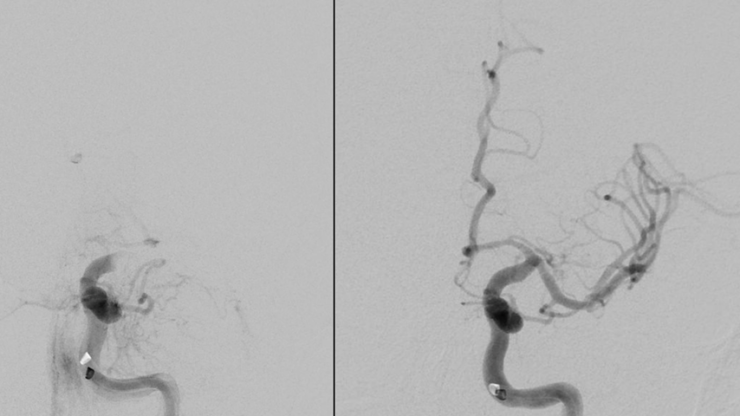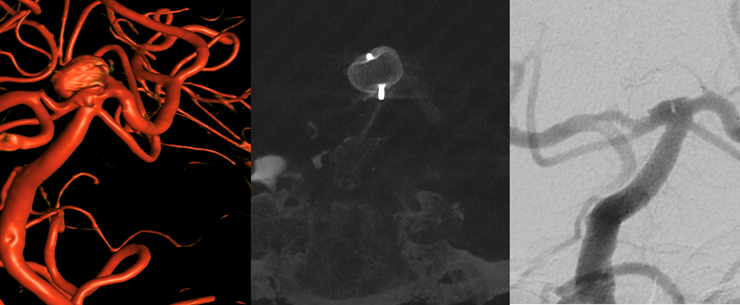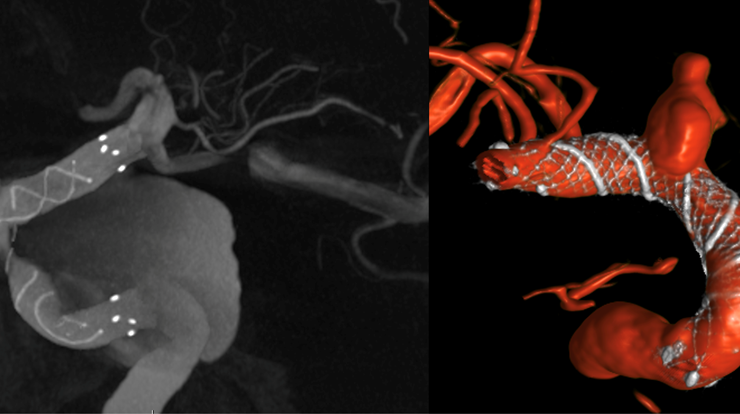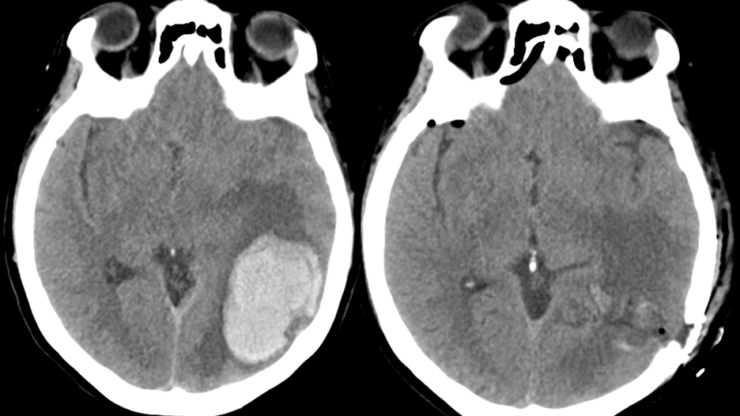Stroke and Cerebrovascular
Cerebrovascular Surgery and the UVA Stroke Center
Neurosurgeons Andrew Carlson and Ryan Kellogg, together with interventional radiologists, neurologists, and other specialists at UVA’s Stroke Center, deliver the highest standard of comprehensive care in Virginia for patients with strokes and other cerebrovascular disorders. Their expertise covers the treatment of ruptured and unruptured cerebral aneurysms, intracerebral hemorrhages, brain and spine vascular malformations, cavernomas, carotid artery disease, and neurological conditions requiring bypass surgery.
Ischemic Stroke
UVA is unique in its region for being able to administer certain early treatments that might reverse the effects of a stroke, making it essential to get immediate treatment. UVA’s acute stroke intervention team is available 24/7 and provides the most comprehensive care for ischemic stroke. This stroke type occurs due to a clot obstructing blood flow to the brain and accounts for nearly 85% of all strokes. The management of acute ischemic strokes has vastly improved with the advent of mechanical thrombectomy, a procedure used to extract the clot. By navigating through the arteries, these devices can clear blockages from brain arteries, restoring blood flow and significantly lowering the risk of severe disability or death from a stroke.
comprehensive care for ischemic stroke. This stroke type occurs due to a clot obstructing blood flow to the brain and accounts for nearly 85% of all strokes. The management of acute ischemic strokes has vastly improved with the advent of mechanical thrombectomy, a procedure used to extract the clot. By navigating through the arteries, these devices can clear blockages from brain arteries, restoring blood flow and significantly lowering the risk of severe disability or death from a stroke.
Angioplasty and stenting can be done before, during, or after a stroke to lower the risk of another ischemic stroke. Additionally, carotid endarterectomy or transcarotid artery revascularization can also be performed to reduce the risk of future strokes. The capability to offer these procedures allows for UVA to tailor treatment to provide the optimal care for an individual patient.
Learn more about types of strokes, warning signs and prevention at the UVA Stroke Center page.
Brain Aneurysms and Hemorrhagic Strokes
A brain aneurysm is a weakened, bulging area in a brain artery, leading to an abnormal ballooning. This weak spot risks rupture, causing significant brain bleeding. If an artery ruptures and bleeds into the brain, neurons and tissues lack oxygen and nutrients, potentially resulting in brain damage or death if not promptly treated.

There are two primary surgical treatments for a cerebral aneurysm:
Microsurgical Clipping, where the neurosurgeon removes part of the skull, exposing the aneurysm, and places a titanium clip across the neck of the aneurysm to prevent blood flow into the aneurysm.
Endovascular surgery, a minimally invasive technique, where a catheter is advanced from a blood vessel in the wrist or groin up into the blood vessels in the brain. This catheter provides access for additional devices (stents, coils, flow diverters) to treat the aneurysm from inside the artery to prevent rupture.

Intracerebral Hemorrhage

Intracerebral hemorrhage (ICH) is a severe form of bleeding stroke, often related to hypertension. Neurosurgeons at UVA are involved in the care of all patients admitted with ICH. Acute treatment in the intensive care unit is aimed at stabilization, while surgical evacuation of the hemorrhage is needed to reduce brain pressure and further damage to the surrounding tissue in select patients. Subsequent subacute and chronic treatment is undertaken for rehabilitation and treatment of underlying disorders.
Vascular Malformations
Arteriovenous Malformations (AVMs) are abnormal collections of blood vessels which obstruct certain tissue from receiving nutrients in the normal course of blood circulation, and can be prone to bleeding and cause severe and potentially fatal strokes.
Comprehensive management of patients harboring AVMs involves three main therapeutic modalities: endovascular surgery,  microsurgery and stereotactic radiosurgery. UVA excels at all three, including extensive experience with radiosurgical treatment of AVMs with its Gamma Knife. This comprehensive care extends to the management of spinal vascular malformations and CSF-venous fistulas as well.
microsurgery and stereotactic radiosurgery. UVA excels at all three, including extensive experience with radiosurgical treatment of AVMs with its Gamma Knife. This comprehensive care extends to the management of spinal vascular malformations and CSF-venous fistulas as well.
To learn more about AVMs and Cavernous Malformations, click here.
Facilities
Patient care facilities encompass the Neuro Intensive Care Unit, intermediate care unit, and the Stroke Center ward. The neurosurgical operating rooms feature cutting-edge equipment such as surgical microscopes with 4K video output, image guidance navigation systems, advanced endoscopic tools, intra-operative ultrasound, and intra-operative angiography capabilities. Biplane diagnostic and interventional neuroradiology suites enable endovascular surgery with the highest quality imaging capabilities. All these facilities are managed by highly skilled staff dedicated to providing excellent patient care. The Lars Leksell Center for Gamma Knife Surgery provides advanced treatment for AVMs.
Advanced Research
We are dedicated to improving future care and outcomes through clinical and laboratory research, as well as through the education of tomorrow’s health care providers. We are conducting ongoing clinical and laboratory research to examine subarachnoid hemorrhage, cerebral vasospasm, ischemic stroke, intracerebral hemorrhage and endovascular and minimally invasive therapies.
When appropriate, patients are evaluated and offered the most current and promising treatments available through the clinical trials program.
Recovery and Special Services
Patients undergo recovery in the Neuro Intensive Care Unit and in the Stroke Unit – units with staff trained specifically for the care of patients in need of intensive observation following a stroke. The nurses understand the unique medical requirements of patients recovering from various types of stroke. Physical, occupational and speech therapists work entirely with patients who are overcoming strokes and other neurological problems to assist in recovery and that often requires continued treatment after leaving the hospital. Following outpatient rehab service, in select patients with persistent arm weakness following an ischemic stroke, neurosurgeons at UVA offer surgery to help restore arm function through implantation of an electrode.
Additionally, social workers assist patients with a range of needs, from returning to work after a stroke to dealing with social and medical issues following a major cerebral injury.
Patients who have suffered a stroke and their families may be under a great deal of stress or in need of additional assistance. See UVA’s Patient Information page to learn about all the patient and guest services available to make your stay as comfortable as possible. Children who suffer strokes receive treatment and rehabilitation in conjunction with the special services of UVa’s Kluge Children’s Rehabilitation Center.
Vascular Conferences
The Stroke Center offers a setting where neurosurgeons, radiologists, neurologists, and other healthcare experts convene weekly in a formal conference to discuss contemporary vascular issues and the management of complex cases. Through education and pioneering research efforts, UVA ensures it provides advanced treatments, maintaining its position at the forefront of stroke patient care.
